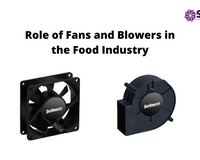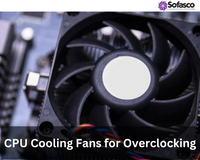Industrial cooling fans play a vital role in numerous industries, providing efficient airflow and ventilation solutions for a wide range of applications. When choosing the appropriate centrifugal fans for a particular application, it is essential to consider various factors, such as the fan's design and performance features. Two commonly used fan types are forward curved and backward curved fans, each with distinct features and advantages.
In this blog post, we will explore the comparison between forward curved and backward curved fans, which is helps to take decision when choosing the ideal fan for your application. By understanding the differences, advantages, and limitations of these fan types, you can optimize your airflow systems for optimal performance.
Forward Curved Cooling Fans
Forward curved fans, also known as squirrel cage fans, are a type of centrifugal fan commonly used in various applications. They feature a curved blade design where the blades curve in the direction of the fan's rotation. This design creates a paddlewheel-like appearance, resembling a squirrel cage, hence the name. The blades are typically mounted on a hub, and the fan assembly is housed within a circular or rectangular casing.
Advantages:
- High Airflow Capacity: Forward curved fans are known for their excellent airflow capacity. The curved blade design allows for efficient movement of large volumes of air, making them suitable for applications that require substantial air circulation.
- Lower Noise Levels: Compared to other fan types, forward curved fans tend to operate at lower noise levels. The curved blades help to minimize turbulence and reduce noise generation, making them suitable for environments where noise reduction is a priority.
- Cost-Effective: Forward curved fans are often more cost-effective compared to other fan types. Their simpler design and manufacturing process contribute to lower production costs, which can make them a budget-friendly choice for various applications.
Limitations:
- Lower Efficiency at Higher Pressures: As the pressure increases, the fan's ability to maintain optimal performance decreases, resulting in reduced airflow and efficiency. Therefore, forward curved fans may not be suitable for applications that require high static pressure capabilities.
- Limited Static Pressure Capabilities: Forward curved fans are better suited for applications with relatively low static pressure requirements. Their design is optimized for delivering high airflow volumes but may struggle to generate significant pressure differentials. Thus, they may not be the best choice for applications where overcoming high resistance or pressure drops is essential.
Applications for Forward Curved Fans:
Forward curved fans find their best applications in scenarios that prioritize high airflow capacity, moderate pressure requirements, and noise reduction. Some common applications where forward curved fans are commonly used include:
- HVAC systems: Forward curved fans are widely used in heating, ventilation, and air conditioning systems, providing efficient airflow for cooling and ventilation purposes in commercial and residential buildings.
- Air handling units: These fans are often employed in air handling units to circulate air within industrial and commercial facilities, ensuring proper ventilation and maintaining air quality.
- Electronics cooling: Forward curved fans are suitable for cooling electronics and preventing heat build-up in components such as computers, servers, and electronic enclosures.
- General ventilation: They can be utilized for general ventilation purposes in warehouses, factories, gyms, and other large spaces that require adequate air movement.
Backward Curved Cooling Fans
Backward curved fans are another type of centrifugal fan commonly used in various industrial and commercial applications. Unlike forward curved fans, backward curved fans have blades that curve away from the direction of the fan's rotation. The blades are typically larger and more curved, allowing for more efficient airflow and pressure generation. Backward curved fans are typically housed in a circular or rectangular casing.
Advantages:
- Higher Efficiency: Backward curved fans are known for their higher efficiency compared to forward curved fans. The curved blade design, combined with the larger blade size, enables better airflow control and reduces energy losses, resulting in improved overall efficiency.
- Better Performance at Higher Pressures: Unlike forward curved fans, backward curved fans excel at higher pressure applications. They can handle increased resistance and pressure drops while maintaining their performance and airflow capacity. This makes them suitable for applications that require higher static pressure capabilities.
- Suitable for Clean Air and Dusty Environments: Backward curved fans are well-suited for applications in clean air and dusty environments. The curved blade design helps to minimize the accumulation of dust and debris on the blades, reducing the risk of performance degradation due to contamination. This makes them ideal for applications that demand clean air circulation, such as cleanrooms or industrial processes that generate dust.
Limitations:
-
Higher Noise Levels: One of the limitations of backward curved fans is that they tend to generate more noise compared to forward curve fans. The larger blades and higher airflow capacity can result in increased turbulence and noise production. However, advancements in fan design and technology have led to the development of quieter models, mitigating this limitation to some extent.
-
Higher Cost: Backward curved fans are generally more expensive than forward curved fans. The larger blades and higher manufacturing complexity contribute to the higher cost. However, it's important to consider the long-term benefits and efficiency gains that backward curved fans offer, which can outweigh the initial investment.
Applications for Backward Curved Fans:
Backward curved fans are well-suited for applications that require higher efficiency, better performance at higher pressures, and clean air circulation. Some common applications where backward curved fans are commonly used include:
- HVAC systems: Backward curved fans are often used in HVAC systems for improved energy efficiency and higher static pressure capabilities.
- Cleanrooms: These fans are suitable for maintaining clean air in controlled environments where contamination must be minimized.
- Industrial processes: Backward curved fans find application in industrial processes where high airflow and pressure capabilities are necessary, such as air pollution control systems or industrial ventilation.
- Data centers: Data centers utilize backward curved fans for efficient cooling and airflow management in server rooms.
Factors to Consider When Choosing Between Forward Curved and Backward Curved Fans
Selecting the right fan for your application involves considering various factors that align with your specific requirements. Here are some key factors to consider when choosing between forward curved and backward curved fans:
- Airflow Requirements: Evaluate the airflow volume needed for your application. Forward curved fans are generally better suited for high airflow capacity, making them suitable for applications that prioritize air circulation. Backward curved fans, on the other hand, offer better airflow control and efficiency, making them ideal for applications that require precise airflow management.
- Pressure Requirements: Backward curved fans excel in higher pressure applications, making them suitable for overcoming resistance and pressure drops. If your application requires significant pressure differentials, a backward curved fan may be more appropriate. However, if your pressure requirements are relatively low, a forward curved fan may suffice.
- Noise Considerations: Forward curved fans tend to operate at lower noise levels compared to backward curved fans. If noise reduction is a priority, particularly in settings such as residential or office spaces, forward curved fans may be a more suitable choice. However, advancements in fan design and technology have led to quieter backward curved fan models as well.
- Environmental Conditions: Forward curved fans are generally more suitable for clean air environments, while backward curved fans are better equipped to handle dusty environments. If your application involves dusty or contaminated air, a backward curved fan may be preferable to minimize the risk of performance degradation due to debris accumulation.
- Cost Considerations: Forward curved fans are generally more cost-effective in terms of initial investment, while backward curved fans may have a higher upfront cost. However, backward curved fans often offer higher efficiency, better performance, and longer-term energy savings, which can offset the initial investment over time.
By carefully considering these factors and aligning them with your specific application requirements, you can make an informed decision on whether a forward curved or backward curved fan is the most suitable choice for your needs. Sofasco specializes in designing and manufacturing industrial fans in varied specifications such as axial fans, centrifugal fans, cross-flow fans, blowers, and dust proof cooling. With years of market presence and skilled employees, the company specializes in offering RoHS-compliant and UL-certified harsh environment cooling fans for your needs. Get in touch with their team to know more about these industrial fans.












